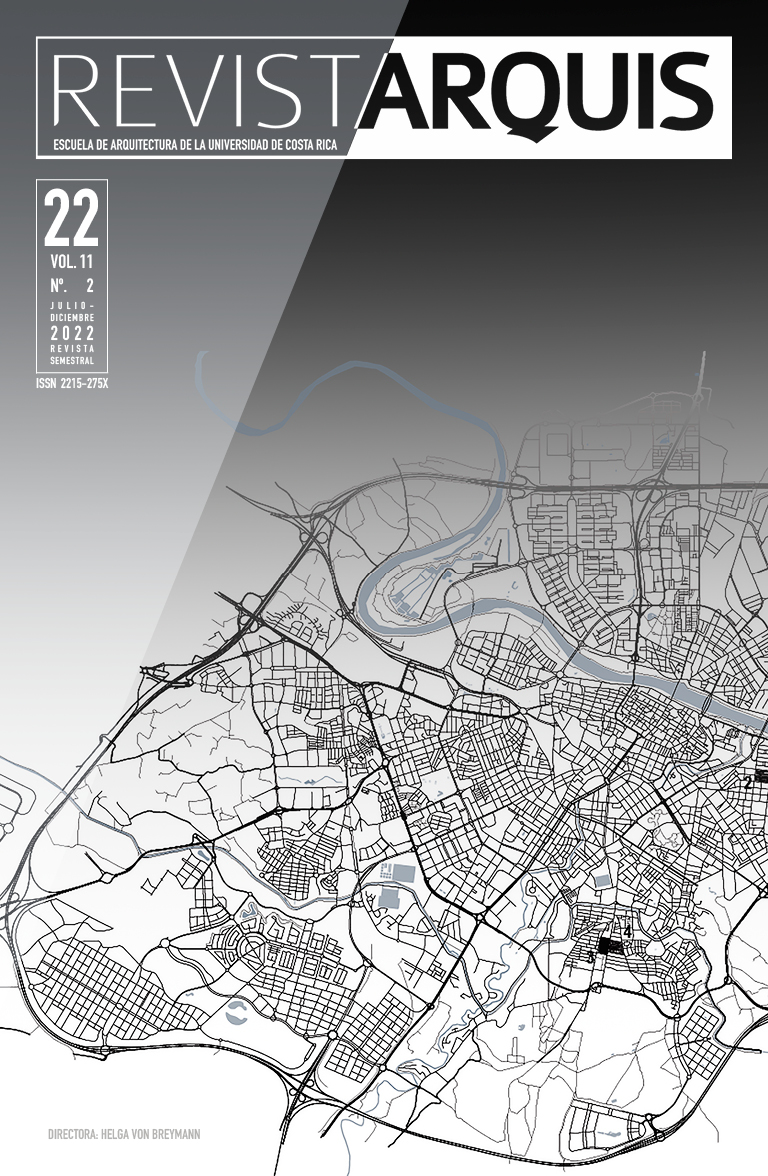Abstract
A problem little examined in the theoretical design are the moods addressed in the built space, for example the feelings of attraction or rejection in certain places, the feeling of belonging to a place, or the solemnity and transcendence in the face of certain urban forms, buildings, or public spaces, like graveyards, churchs, or gardens and squares. In this work it is proposed that in order to know how architecture influences the emotions of the inhabitants, the urban-architectural design specialist must explore their own experiences with the architectural space, and with the social and emotional sphere that is part of it. To demonstrate this, the concept of empathy, social cognition, and social interaction were briefly addressed, based on a bibliographic review of recent theoretical works on urban-architectural design. Theoretical, methodological and epistemic basis of design where compared with others from cultural geography, urban and cultural studies, and cognitive sciences in its embodied aspect, as well as from the hermeneutical tradition on the interpretation of meanings. As case studies, some references on public space and the urban space of historic cities were chosen, as significant elements or forms in the daily life of the inhabitants. It was shown that, although brain activity coordinates social cognition and various emotional states, the urban-social context also determines the meaning of emotions and sensitive experiences, since a socio-spatial process of collective production of meanings occurs through the inter- corporeality and interaction.
References
De la Garza, E. (2018). La Metodología Configuracionista para la Investigación. Gedisa-UAM.
De la Garza, E. y Leyva, G. (Eds.). (2012). Tratado de metodología de las Ciencias Sociales. Perspectivas actuales. Fondo de Cultura Económica-UAM.
Di Paolo, E., Cuffari, E. C., De Jaegher, H. (2018). Linguistic bodies. The continuity between life and language. Massachussets Institute of Technology.
Durt, Ch., Fuchs, T., y Tewes, Ch. (2017). Embodiment, Enaction, and Culture. Massachusetts Institute of Technology.
Flores, J. H. (2015). High-Line de Diller&Scofidio +Renfro+James Corner. [fotografía].
Fuentes, F. (2019a). Sobre la Condición del Diseño Urbano y Arquitectónico: desde el Posmodernismo hasta el Siglo XXI. Revista Estoa, 15(8), 33-42. https://doi.org/10.18537/est.v008.n015.a03
Fuentes, F. (2019b). Complejidad y Constructivismo en la nueva tradición de la arquitectura de la posguerra. Revista de Arquitectura, (Bogotá), 21(1), 34-43. https://doi.org/10.14718/RevArq.2019.21.1.1496
Gallagher, S. (2017a). Enactivist interventions. Rethinking the mind. Oxford University Press.
Gallagher, S. (2014). Coordinación y creación de sentido en la atención conjunta y la acción conjunta en P. King, et al. (Ed), Ciencias cognitivas y filosofía. Entre la cooperación y la integración. Universidad.
Gallagher, S. y Zahavi, D. (2013). La mente fenomenológica. Alianza Editorial.
Gallagher, S., Martínez, S. F., y Gastelum, M. (2017). Action-Space and Time: Towards an Enactive Hermeneutics. Springer.
Giedion, S. (2009). Espacio, tiempo y arquitectura. Reverté.
Lakoff, J. (2012). Filosofìa de carne y hueso en J. Brockman (Ed.), Mente (pp. 13-33). Crítica.
Lindón, A, y Hiernaux, D. (Direct.). (2012). Geografías de lo Imaginario. Anthropos-UAM.
Mallgrave, H. F. (2011). The architect’s brain. Neuroscience, creativity, and architecture. Wiley-Blackwell.
Mallgrave, H. F. (2013). Architecture & Embodiment. The implications of the new sciences and Humanities for design. Routledge.
Mallgrave, H. F. (2015). Mind in Architecture. Neuroscience, embodiment, and the future of design en S. Robinson y J. Pallasmaa (Ed), Mind in Architecture (pp. 9-31). Massachusetts Institute of Technology.
Mallgrave, H. F. (2018). From Object to Experience. The New Culture of Architectural Design.
Mallgrave, H. F. y Goodman, D. (2011). An Introduction to Architectural Theory: 1968 to the Present. West Sussex, John Wiley & Sons.
Montaner, J.M. (2008). Sistemas arquitectónicos contemporáneos. Gustavo Gili.
Moran, D. (2017). Intercorporeality and intersubjectivity: a phenomenological exploration of embodiment en Ch. Durt, T. Fuchs, y Ch. Tewes (Ed.), Embodiment, Enaction, and Culture (pp.25-46). Massachusetts Institute of Technology.
Norberg-Schulz, C. (2005). Los principios de la arquitectura moderna. Reverté.
Otero-Pailos, J. (2010). Architecture’s historical turn. Phenomenology and the rise of postmodern. University of Minnesota Press.
Pérez-Gómez, A. (2016). Attunement. Architectural meaning after the crisis of modern science. Cambridge. MIT.
Robinson, S. y Pallasmaa, J. (2015). Mind in architecture. Neuroscience, embodiment, and the future of design. Massachussets Institute of Technology.
Sánchez, D, y Domínguez, L. A. (Coords.). (2012). Identidad y espacio público. Ampliando ámbitos y prácticas. Gedisa.
##plugins.facebook.comentarios##

This work is licensed under a Creative Commons Attribution-NonCommercial-NoDerivatives 4.0 International License.
Copyright (c) 2022 Francisco Javier Fuentes Farías


